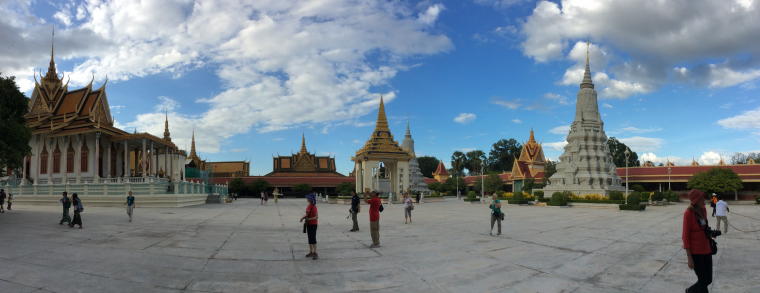|
|
|
|
|
We took a 1-1/2 hour flight from Vientiane,
Laos to Phnom Penh.
|
View of the Mekong River
|
We stayed at the Almond Hotel
|
|
|
|
 |
|
Phnom Penh is the capital of Cambodia with
about 2 million people.
|
Motor bikes are the primary mode of transportation
and are used to haul all types of goods.
|
|
|
|
|
|
|
|
|
|
|
|
|
|
|
Our first stop was to the Royal Palace where
the current king still lives.
|
It is a very large complex including the
Throne Hall where the king's coronation takes place.
|
The Naga or serpent is a dragon-like figure
representing wisdom and a protective force for the Buddha.
|
|
|
|
|
|
|
|
|
|
|
|
|
|
|
.
|
|
|
|
|
|
|
|
|
|
|
|
|
|
|
|
|
|
|
|
|
|
|
|
|
It was 93 degrees so we welcomed a place
to rest.
|
|
|
|
|
|
We visited a school for the arts. Children
from the age of 5 can attend classes in native dance, painting
and music.
|
We watched performances of some traditional
folk dances by the students.
|
|
|
|
|
|
|
They showed us how they fold and prepare the
traditional pants.
|
|
|
|
|
|
|
|
Fred was among our group's volunteers to
try on traditional clothing and participate in dances.
|
Fred and Loni learn a dance step.
|
|
|
|
|
 |
Click here
to watch short video of their dancing. |
|
|
|
|
|
|
|
Young painters.
|
Beautiful art work, unfortunately not for
sale.
|
|
|
|
|
|
|
Demo of the traditional musical instruments
|
Fred tries his hand on some of the instruments.
|
|
|
|
|
|
|
Our local guide, Leng, provides information
about Cambodia on the bus.
|
|
Small shrines for sale along the street.
|
|
|
|
|
|
Visit to the Choeung Ek Genocidal Center,
also known as the Killing Fields.
|
As we walked around the site, we could still
see fragments of bone and pieces of clothing on the ground.
|
This center was one of 300 mass grave sites
in Cambodia. It was found and excavated in 1988.
|
|
|
 |
|
|
Killing Tree against which executioners
beat children.
|
Pieces of bone that were found during the
excavation.
|
Some of the bones, skulls and clothing found
in the mass graves have been placed in a 19 story memorial
stupa.
|
 |
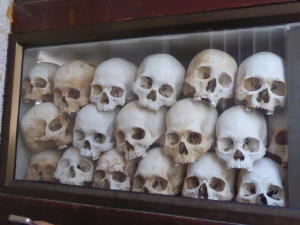 |
 |
|
8000 skulls are arranged according to age
and sex.
|
|
Victims' clothing.
|
|
|
|
 |
|
Our next stop was the Genocide Museum, formerly
known as S21. It was here that the prisoners were taken and
tortured into confessions of treason to the Khmer Rouge, during
the reign of Pol Pot. The photo is one of the 4 buildings
of S21 housing prison cells.
|
Rules to be followed by the prisoners, otherwise
they would be lashed with electric discharges. Click on photo
to read.
|
Public flogging area
|
 |
 |
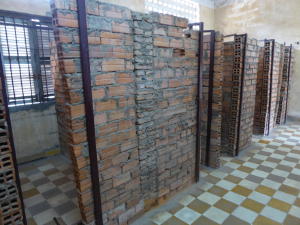 |
| |
Manacles
|
Prison cell
|
 |
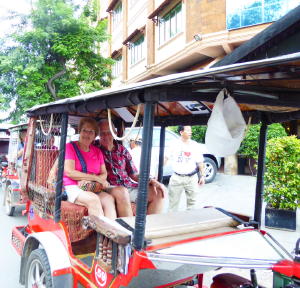 |
 |
|
We took a 45 minute ride in a remok, the
Cambodian version of a tuk-tuk or 3 wheeled rickshaw, to visit
one of the 7 survivors of S21.
|
|
This was an E ticket ride during rush hour.
|
 |
 |
 |
|
Cars, motor bikes, bicycles and buses all
fought for the same space on the road as the remoks. There
were no traffic lights or stop signs!
|
|
|
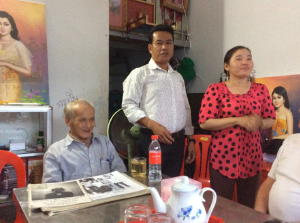 |
|
|
|
The man on the left is the survivor of S21.
He is now 72 years old. His granddaughter is on the right.
Our guide, Leng, is in the middle.
|
|
|
|
|
|
|
|
A delicious lunch.
|
Door handle at the restaurant.
|
Main electrical pole!
|
| |
|
|
| |
|
|
To learn more about our trip around Phnom Penh, including information
about the killing fields and the reign of Pol Pot, go to the Phnom
Penh Newsletter. To view the next photo gallery, go to
Siem Reap Photo Gallery.
